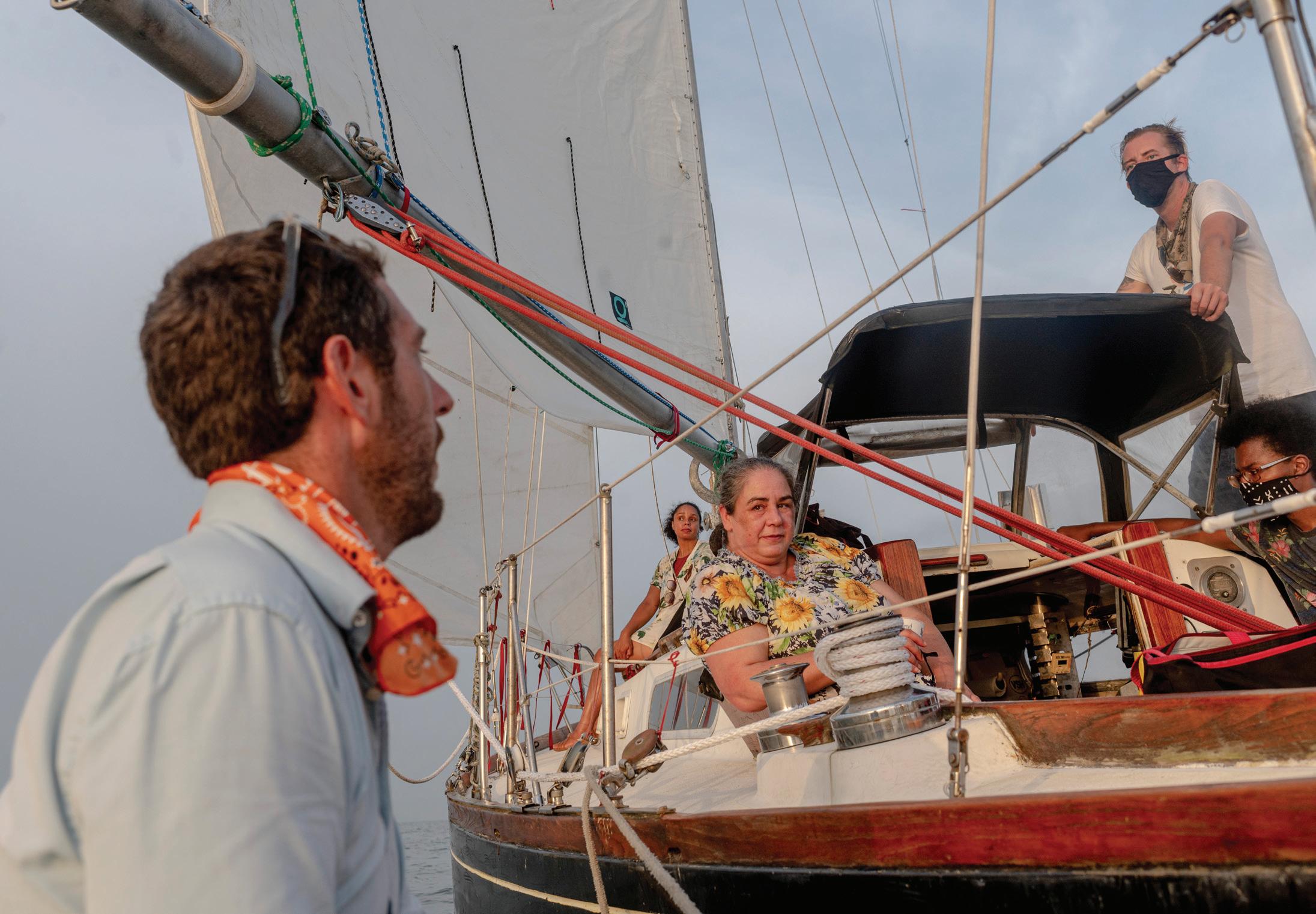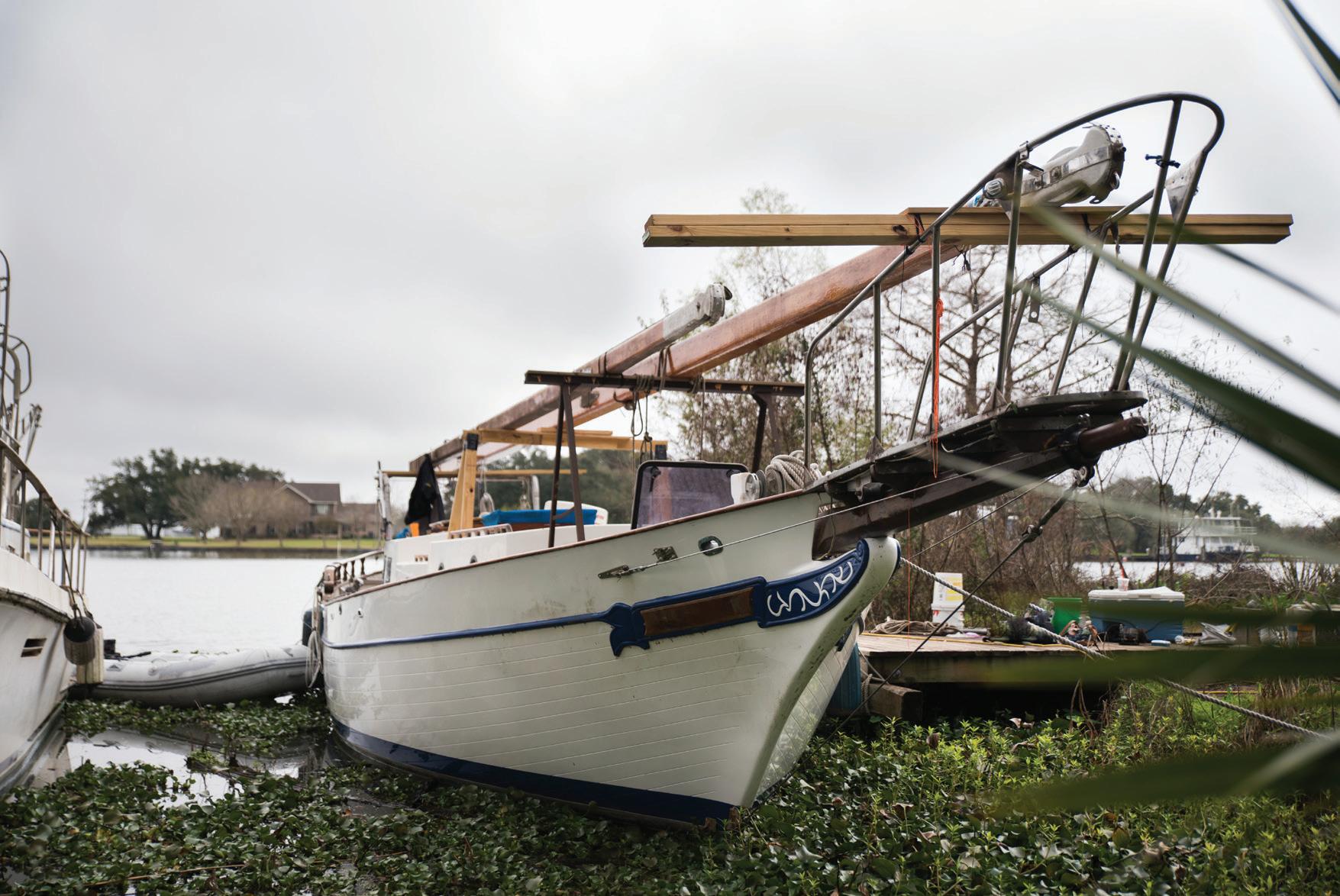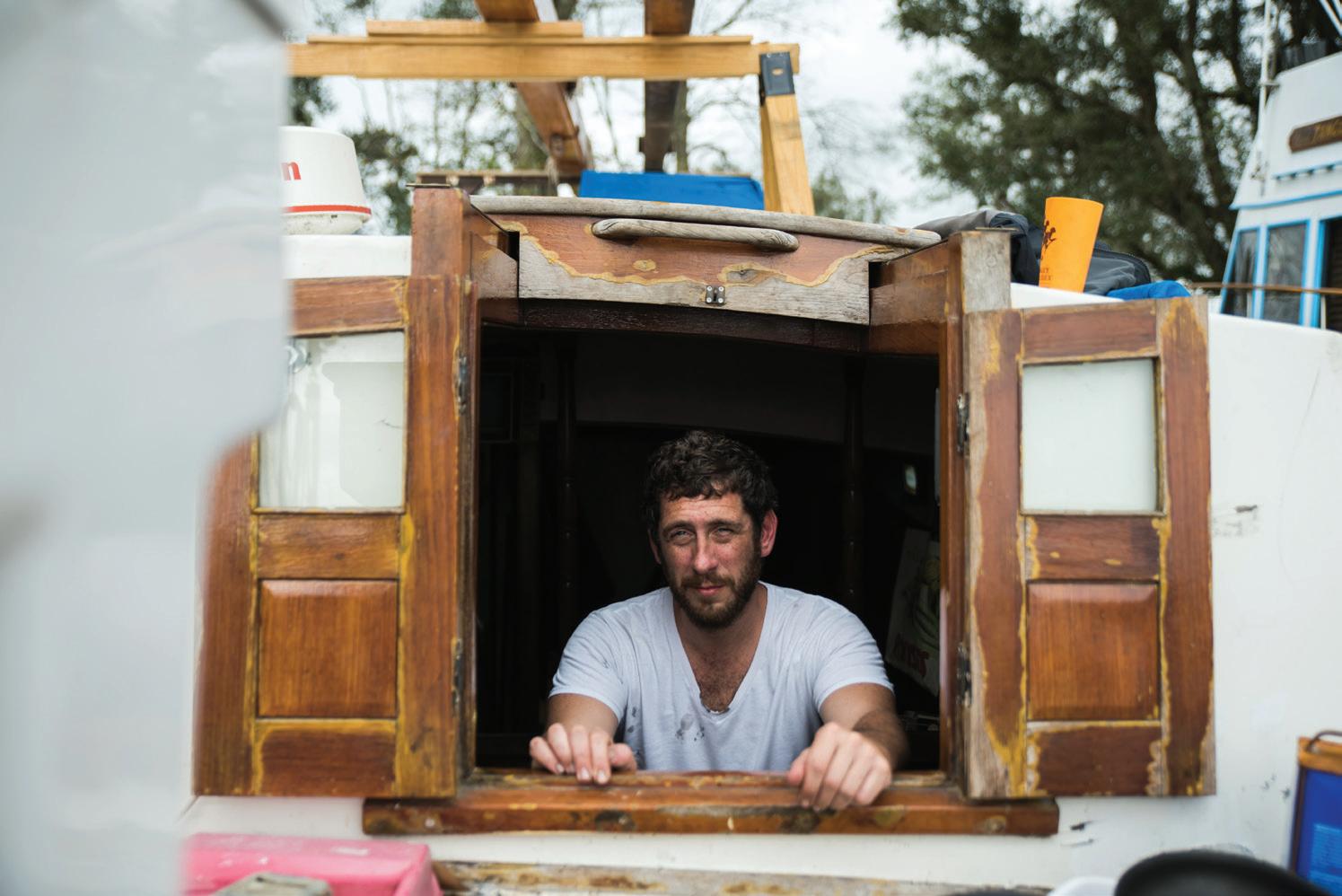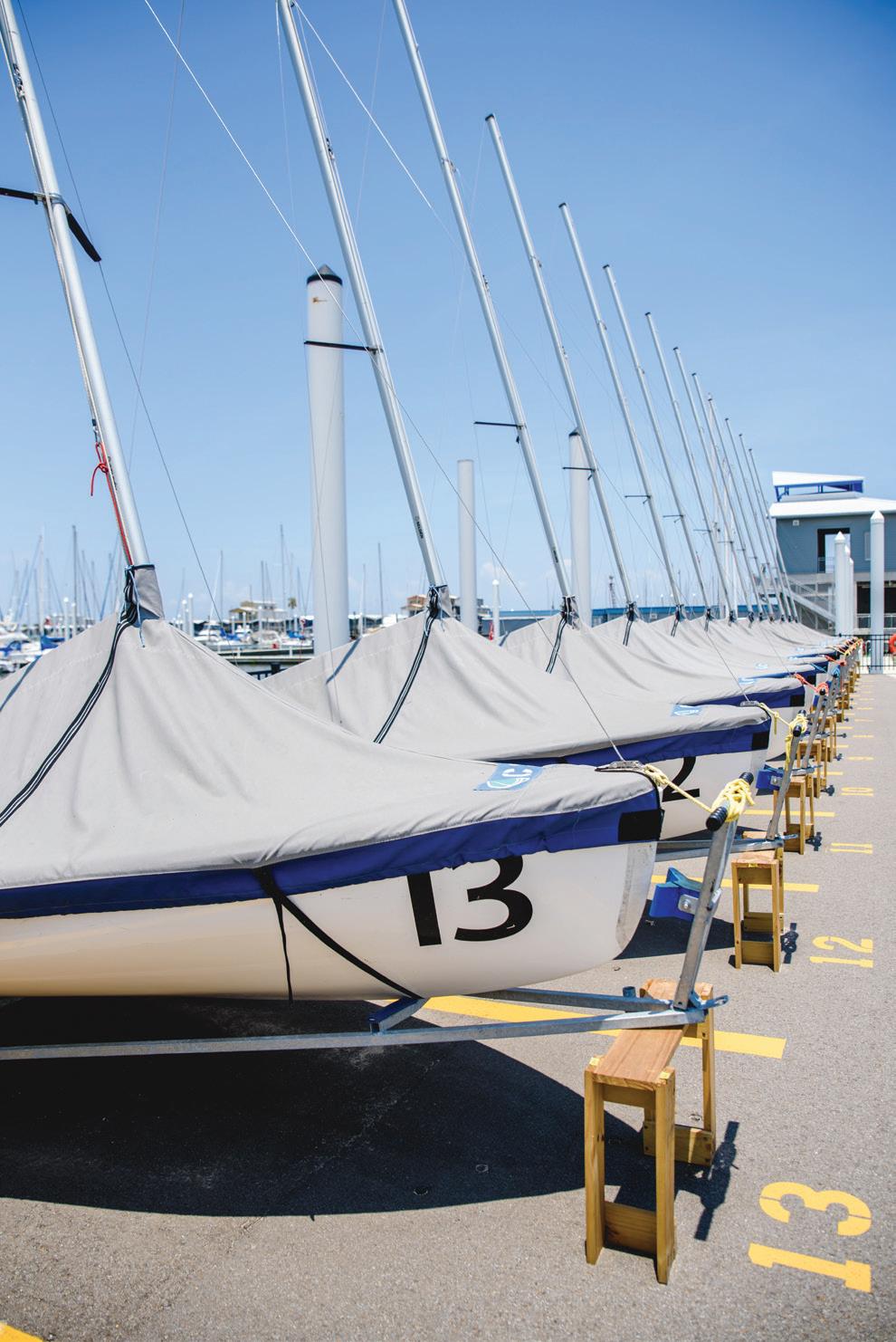
12 minute read
Sailing for Everyone
AN ANCIENT RITE, MADE ACCESSIBLE TO ALL
Story by Christie Matherne Hall
Photos by Emily Kask
As a civilization, “we’ve basically done... everything we’ve ever done, by sailing,” said David Lewis, founder of the Pontchartrain’s newest sailing charter company, All Aboard NOLA. With a mission to provide a sailing experience and––eventually––sailing instruction to everyone, Lewis hopes to reach people who might have never been in the right room to receive a sailing invitation. He thinks sailing should be in everyone’s bucket—not just people who run in certain circles or have the money to buy a boat, or kids who go to certain schools, or people of certain races or genders, or heterosexuals. If someone hasn’t ever been invited to sail, for whatever reason, through All Aboard NOLA, he wants to invite them.
After twelve months of restoring the Mai Tai Two, his fifty-foot ketchrigged sailboat, Lewis’s dream really started taking shape in January of this year, with more renovations always underway. But first, the Mai Tai Two had an important voyage to make, from Patterson, Louisiana—where she had been languishing for nearly a quarter century—to her new home on Lake Pontchartrain, via the Intracoastal Waterway.
Restoring an old sailboat, however beautiful and fulfilling, is an enormous effort. Lewis is a former gunner’s mate of the U.S. Navy, so he is what he calls a “boat person.” But the past year has taught him that no one can restore a fifty-foot, dual-masted sailboat on their own. Sanding baked-on varnish from the impossibly tall masts, repairing a squirrel-eaten sail the size of a living room, and siphoning wayward oil from a coolant tank required the help of anyone and everyone Lewis could find, experienced or not, willing to lend a hand–-including his fiance Laura Sanders and crewmate Mark Lucas.

After restoring a fifty-foot ketch-rigged sailboat and transporting it via towboat escort on a six-day journey across the Intracoastal Waterway, David Lewis was ready to launch his inclusivity-conscious sailing charter company, All Aboard NOLA last spring. With the rise of COVID-19 though, the company waited until the summer to begin operations, and is now offering private excursions
Photo by Emily Kask
To make the voyage from Patterson, Lewis would once again need all the help he could get. The route involved a five-mile Mississippi River crossing, which would be especially dangerous in January’s high water. “The river is high,” Lewis explained. “But there’s no reason I can see to put it off, and every reason to go as soon as we can.”

Both All Aboard NOLA and Community Sailing New Orleans aim to push against centuries-old perceptions of who sailing is for, and to foster environments where people of every race, gender, sexuality, and even age can safely and comfortably experience the riches this ancient sport has to offer. Pictured: Captain David Lewis (left) and crew member Mark Lucas (standing far right) pictured with guests on a recent excursion on the company’s second ship, the _True Love_.
Photo by Emily Kask
Remarkably, just as Lewis was preparing to embark on All Aboard NOLA’s journey towards inclusive and accessible sailing on the Pontchartrain, another nonprofit—after ten years of preparation—was preparing its own public debut.

After restoring the fifty-foot ketch-rigged sailboat, the Mai Tai Two, to seaworthiness, Captain David Lewis had to get his ship to the Pontchartrain—an arduous six-day journey along the Intracoastal Waterway and across the Mississippi River with the river level running at near record highs.
Photo by Christie Matherne Hall
Community Sailing New Orleans, a nonprofit committed to providing accessible sailing and educational opportunities on Lake Pontchartrain for people of all ages, genders, backgrounds, and abilities, has been building toward a mission of expanding the borders of sailing enthusiasm mission since its founding in 2010.
Between the tasks of acquiring lakeshore property, developing an experienced advisory board, building bulkheads and docks, and collecting the necessary vessels for community access, it took Community Sailing New Orleans a decade of preparation to be ready for the public. Executive Director Jacob Raymond was hired in March, shortly before the organization’s public opening—which, unfortunately, fell right atop the first COVID-19 outbreak.

All Aboard NOLA’s two ship fleet includes the _True Love_, captained by Christopher Peragine (pictured above) and the Mai Tai II, captained by David Lewis (pictured just below).
Photo by Emily Kask

Photo by Christie Matherne Hall
With a sixty-five-year site lease, forty-nine vessels (including ten paddleboards), and equipment to facilitate sailing for people with disabilities, Community Sailing New Orleans distinguishes itself from All Aboard NOLA—an L3C, two ship fleet focusing on private party excursions–– as a larger entity with cooperative, educational, and therapeutic purposes.
But both are seeking to fill the gap of inclusive sailing access in the New Orleans area.
One of the primary barriers to sailing, for most people, is the price tag. Anyone wanting to purchase their own sailboat is looking at a few thousand dollars investment, at least. Boat owners will also need a place to put their boat, which could mean a costly year-round marina bill—and of course, there are hefty insurance and maintenance costs.
“Boat ownership is very expensive,” Raymond said, “but I don’t believe that prohibits people from enjoying sailing. There are a lot of different avenues and approaches you can take to get on the water.”
For instance, Corinthians Sailing, a sailboat racing nonprofit organization, will allow anyone to crew a sailboat on Wednesday nights. “You just have to introduce yourself and put yourself out there," Raymond said.
For women, there’s the Lake Pontchartrain Women’s Sailing Association, which offers a $75 annual membership that includes year-round access to the club boat, Femme Fatale; crew matching for Wednesday night races, social events, and more.
The U.S. has experienced an upswing of community-based sailing nonprofits nationwide, which generally offer lower-priced or free lessons and memberships to those who qualify. They have served to ease the financial burden of entry to sailing. That said, Community Sailing New Orleans is the only community initiative of its kind in Louisiana, as far as Raymond is aware. Lowering prices, though, doesn’t automatically open the door to sailing for everyone. The way people think about sailing needs to change, too. Sailing has a longtime perception of exclusivity as a sport for the affluent, the white, the able-bodied, and the male, and the reputation is often enough to bar sailing opportunities from the imaginations of many.
“I think when people hear sailing, they think of this very elitist and very exclusive kind of sport,” said Raymond. “Community sailing programs deconstruct people’s perceptions of what sailing is. This isn’t the seventy-two-foot cruising yacht serving cheese and crackers, with people wearing blazers and fancy deck shoes.” Before Lewis purchased the Mai Tai Two, he worked a few months in Connecticut on the Amistad—a replica of the historic Spanish schooner of the same name, which was famously commandeered by kidnapped Africans in 1839. Discovering Amistad, the nonprofit organization which currently owns the replica Amistad, has a program that welcomes local school children aboard to get a hands-on history of the Amistad Uprising of 1839. It’s an empowering experience for the children who come aboard—about 85% of whom are children of color.
“We took the kids out into Long Island Sound and let them experience some of the things that sailors would have experienced in that time,” said Lewis. “As much as the history of this rebellion is interesting, these people [who commandeered the Amistad] are commonly called slaves, but they weren’t slaves. They were kidnapped illegally, in the sense that importing slaves from Africa had been illegal for fifty years at that point—maybe more. They were never sold. They never were put to work. They were on their way from one end of Cuba to the other when they rose up and took command of the vessel and managed to pilot it all the way up the eastern seaboard—not any of them knowing how to sail at all.”

Photo by Emily Kask
Inviting children aboard a tall ship can leave a big impression—one that sticks with them for years to come. “Most of the kids [who visit the Amistad] are thrilled, because many of them have never been out on a boat before,” said Rose Witte, former Captain of the Amistad. “And giving them the experience of sailing, and getting the sails up, and feeling the wind fill the sails, and taking turns driving the boat—that’s the thing that really gets me. [...] [After the field trips], the kids would come back and work on the boat. They fall in love with sailing, and the ship.”
In her time as Captain, Witte was also committed to getting Black children involved in sailing and the maritime industry. “There is a history of Black mariners in fishing and in the professional maritime trade, and it’s sort of gone by the wayside a bit,” she said. “There’s not as many now. And it’s worse in sailing.”

Photo by Emily Kask
While on the replica Amistad, Lewis met and worked under Witte, who is one of few female mariners of her caliber in the field. Witte grew up sailing in Chesapeake Bay—her grandfather showed her the ropes, as he had shown her mother. Witte worked summers in shipyards and on boats from an early age, and earned her Coast Guard certification at age twenty-two.
History has a long habit of keeping women off of boats in general. The British Navy legally barred women from boarding military ships in 1808, and the U.S. Navy only assigned its first women aboard a combatant ship in 1994. Despite the common practice of naming ships after women and references to “her maiden voyage,” plenty of old mariner accounts describe women aboard a ship as bad luck, presumably because they could rouse jealous attitudes among male sailors. (That said, topless or naked women were considered good luck onboard a sea vessel. Supposedly, a barechested woman could “shame nature into suppressing its anger.” Redheads were also considered bad luck on a ship, as were bananas.)
Today, women represent only two percent of seafarers worldwide. Clearly, some barriers remain. A 2019 World Sailing Trust study, comprised of over 4,500 sailors worldwide, found that 59% of women surveyed had experienced “some form of discrimination within the sport.” Reports of discrimination included “isolation and harassment, being treated as less competent, not receiving the same opportunities and level of support as male sailors, and being stereotyped by gender.” Participants in the study were 73% female.
With over thirty years of professional sailing behind her, Witte has experienced more than her fair share of gender discrimination. Among other things, Witte has heard men mocking women’s high-pitched voices in maritime communications. “Sometimes they’d hold the microphone up to a speaker playing crying baby noises,” she said.
“There are times where it’s just so overt that it causes trouble,” Witte explained. “If I have somebody coming onboard and I see them acting in a domineering way that is upsetting to the female members of the crew—for instance, a guy coming in and taking a line out of a woman’s hand, while she’s working it perfectly—I see it coming, and I don’t tolerate it.”
Community sailing initiatives consider diversity—of culture, ethnicity, race, gender, age, beliefs, religion, socioeconomic status, sexual orientation, family status, physical ability, appearance, and ideas—as a mission cornerstone.
“Where you have diverse perspectives, you have diverse solutions to diverse problems, and everyone’s experience has something to bring to the table,” Lewis explained. “And I don’t think that having a monolithic community on board a sailing vessel is as productive as that spectrum of perspective.”
Nearly a month after its original departure date, on the overcast morning of February 16, the Mai Tai Two— crewed by Captain Lewis and invaluable crew member Mark Lucas—finally left Patterson with a working engine. (Sanders was unable to join due to a scheduling conflict.) They were preceded all the way to Houma by another vessel, owned by the Mai Tai Two’s previous captain. They stayed in Houma for the Krewe of Aquarius parade, then they were off again, dodging bigger boats and navigating heavy winds. The Mai Tai Two was tied to a rusty 1950s dredge near the Harvey Canal for several days to wait out some bad weather— Lewis mentioned that, lashed to a dredge, the Mai Tai Two looked like “she had tugboat dreams”—but they were able to prepare for the Mississippi River crossing soon thereafter. For the crossing, they were joined by Christopher Peragine, captain of All Aboard NOLA’s second ship, _Truelove_.
Fastened at the hip to the Aunt Donna, a hired towboat escort, the Mai Tai Two crossed the big river at over fifty percent more volume than it usually holds. Due to the wakes of several large, outbound ships, the Mai Tai Two lost half its Samson post; and it lost a fender to a bump with the Aunt Donna. Lewis said the bump “woke everyone up”— it sounded like a gunshot. Ketch and crew made it to Lake Pontchartrain on February 22, six days after embarking from Patterson. The bilge was dry, the boat was (mostly) seaworthy, and she proved herself capable of crossing the Mississippi lashed to a towboat— something she was not designed to do.

Community Sailing New Orleans has spent the past ten years preparing to open up its forty-nine vessel fleet— and accessible community sailing—to the people of New Orleans. Executive Director Jacob Raymond (pictured below) says they plan to begin offering services this fall.
Photos by Christie Matherne Hall

Now living happily in New Orleans, not only will the Mai Tai Two—and the _Truelove_—take people out on Pontchartrain cruises, but Lewis wants to eventually add an educational component––a “captain factory,” as he calls it. But for now, the Mai Tai Two and _Truelove_ are available to book for private excursions until the COVID-19 pandemic is resolved by a vaccine or diminishes significantly. Private cruises start at $65 per person.
Community Sailing New Orleans is slated to begin phasing in some services by fall of this year as well, pending local health recommendations regarding COVID-19. By Spring of 2021, the organization will have sixty boats of various types to suit the needs of its participants, including those with disabilities. The general public will be able to sign up for Community Sailing New Orleans’ adult sailing courses for $300. Annual all-access passes—which allow students, individuals, or families to take out a boat—will range from $250- $500. There will also be women-only programming in the future.
“We’re going to be running scholarships for youth and adaptive sailing, so there’ll be little to no cost for people who qualify for our community development programs,” said Raymond.
Sailing requires teamwork, intense focus, quick observational chops, the ability to adapt to rapidly changing environments, and improvisation skills. These qualities can only improve with a diverse crew—and by its nature, the work itself improves everyone who participates in it.
“There’s just so many opportunities for profound personal growth on board a vessel like this, or any other sailing vessel,” Lewis continued. “It’s hard work. And it’s extremely rewarding, and it’s exacting, and it requires a lot of discipline—a lot of personal discipline—and resourcefulness. There’s very few things that will give you such a measure of self-confidence like weathering a significant storm or other adverse conditions presented by the sea.”
“And there’s also I suppose, a bit of faith involved. Mostly faith in yourself, I think, but that’s what you grow with it.”
allaboardnola.com nolacommunitysailing.org lpwsa.org corinthians.org










